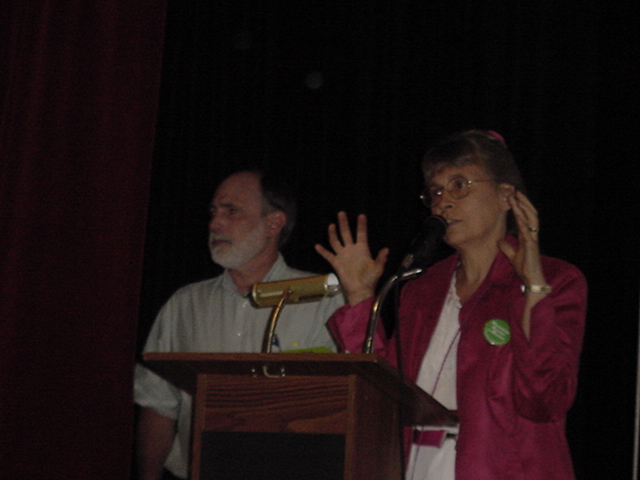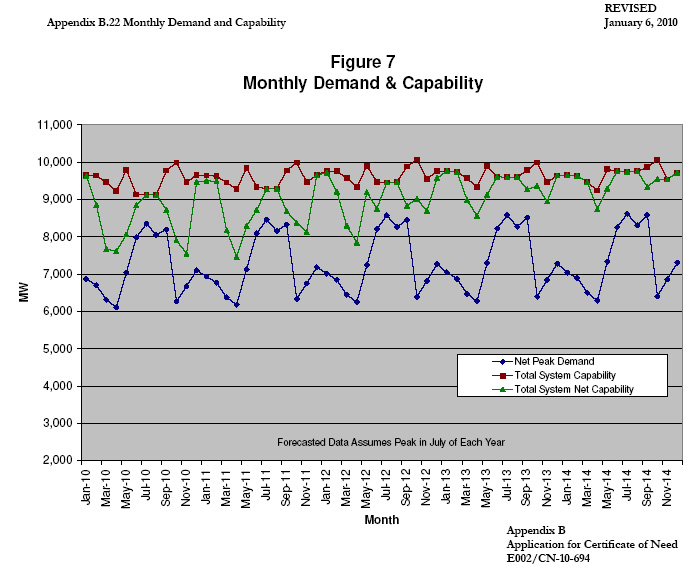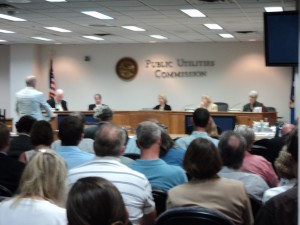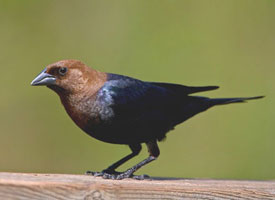Xcel files “Testimony” in Hiawatha transmission docket
September 30th, 2011
 Xcel Energy filed “Testimony” in the Hiawatha Project Certificate of Need docket. It’s odd, there are NO intervenors in this docket, everyone from the Routing docket is sitting this one out. WHY???
Xcel Energy filed “Testimony” in the Hiawatha Project Certificate of Need docket. It’s odd, there are NO intervenors in this docket, everyone from the Routing docket is sitting this one out. WHY???
Here’s the testimony:
Note that they go on and on about how peak load has increased, or is it has almost equaled the 2006 peak… which is it?
Look carefully at the charts on pages 30-32. Here’s the one on p. 32 (click for bigger chart, you’ll need it!)
Now let’s compare this with prior info:
And from their Hiawatha Project filings, first their REVISED chart (click for larger version):
And this was their original:
And remember, this was the stuff that MOES, errrrr, the agency formerly known as MOES, had a hissy fit about my Commenting on Xcel info about peak demand!!!!
I need to read this, have only skimmed it so far, but I trust there will be a way to address this stuff in the record???
Goodhue Wind Truth appeals PUC Order
September 22nd, 2011
It’s a complicated thing. The PUC made its oh-so-contorted decision on AWA’s Goodhue Wind Project:
And then we filed our Motions for Reconsideration… here’s one:
Today AWA filed their respose:
For all of them, go to www.puc.state.mn.us and click on the blue “Search eDockets” button and search for docket “08-1233” and “09-1186.”
So far on the Appellate site and the filings that we’ve exchanged (the Notice of Appeal was in my inbox before I got back to Red Wing, with a reference to Belle Creek, though not Goodhue County’s but their filings were in the inbox!):
Belle Creek Township’s Appeal – Initial Filings – Petition for Writ and Statement of Case
GWT – Appeal Notice & Initial Filings – Petition for Writ and Statement of Case
No Appellate Docket yet – Goodhue County
Goodhue County Appeal – Initial Pleading – Petition for Writ and Statement of Case
No Appellate Docket yet – Coalition for Sensible Siting
CSS Appeal – Initial Pleading – Petition for Write and Statement of Case
This is shaping up to be a “robust” appeal… I’m so tickled to see the county’s recognition and appreciation of Goodhue Wind Truth’s efforts (really, read the pleadings). And personally, it’s a thrill to see how far we’ve come since the struggle of the nuclear “in Goodhue County” days.
Alan Muller featured in Delaware Today
September 19th, 2011
Alan Muller ‘s office in Lake Itasca Park
And at a Rock-Tenn Burner Fest in St. Paul, being introduced by Nancy Hone, Neighbors Against the Burner:

Here’s a profile of Alan that was published in Delaware Today:
Alan Muller takes no prisoners.
His wrath spares few of those in power. Here’s a sampling:
Of the State Chamber of Commerce: “Probably the biggest single foe of the environment in the state.”
His scorched-earth style can elicit bitter backlash. Says John Taylor, senior vice president of the State Chamber of Commerce: “Alan Muller is great at name-calling but lousy on getting his facts right. Mr. Muller attacks anyone who doesn’t agree with him 100 percent. And his narrow, misguided and misanthropic vision is well-known to those in Delaware who truly care for the environment. In fact, the Delaware State Chamber of Commerce has been an active partner in bringing clean energy to Delaware. The latest example of this being the Bloom Energy decision to come to Newark.” While Taylor no doubt expresses what many would like to, other Muller targets chose a more circumspect response. Markell, who gets high marks from many enviros, would say only, “Alan Muller believes strongly in his causes and makes himself heard.” Chris Coons’ office declined to comment. Another Muller target, Debbie Heaton, of the Sierra Club and The Nature Conservancy, says merely that she does not have “happy memories” of working with him.
The official response to Muller is often to ignore or avoid him. That’s understandable, according to John Flaherty, another well-known Delaware activist. “Power hates and marginalizes people who are right, like Alan, because they reveal that the powerful use their positions for themselves and for the interests they serve. And once someone has been banished to the margins, the powerful can rely on the conditioned habits of the public. After all, don’t we all know that anyone on the margins is, by definition, unacceptable?”
According to Muller and some of his supporters, he’s been mistreated and harassed over the years—especially by New Castle County government, which has cited him for many violations at his Port Penn home, a historic building he purchased for about $15,000 (supplemented by a state grant) with the agreement to upgrade it. Muller says the price of the house and its central location between Wilmington and Dover cancels out environmental considerations like the three nearby nuclear reactors, the Delaware City Refinery and other major polluters.
In 2001 Baker had him arrested for “graffiti” and “criminal mischief” after Muller posted warning signs on an open channel carrying raw sewage through a Brandywine Park picnic area. In 2005 he and John Kowalko, then director of the ACORN utility campaign, now a state representative, were ejected from Legislative Hall during a House Energy Committee hearing. When they weren’t allowed to speak, Muller and Kowalko tied gags to their mouths. That incensed then-Rep. Robert Valihura, chairman of the committee, who ordered Capitol Police to remove them.
Calling it “death by a thousand cuts,” Muller says “harassment in the past few years has been relentless.”
Meanwhile, he laments the “plantation mentality” that pervades the state—“the reluctance of people to say anything challenging or critical,” including the media and other environmental organizations. The latter, he says, have been bought off or bullied into submission by those in power. “Other states are less hostile,” he says.
As a result, the somewhat rumpled 61-year-old, nursing “aching feet and a creaky back,” may leave Delaware, perhaps for Minnesota, where his soul mate, Carol Overland, is an energy consultant and lawyer. He spends about half of each year working for environmental groups in several states, at fees exceeding the small income he takes from Green Delaware.
As the most prominent activist in the state’s recent past contemplates taking his leave, it seems an appropriate time to examine his legacy—and his motivation.
For someone so passionate about it, Muller came relatively late to the environmental movement. But the seed was planted early. He grew up in Welshire, a North Wilmington suburb, living with his parents and a brother, who was a year younger. His father, Joseph, was a DuPont manager.
“I’m not saying my father was a bad guy,” Muller says, “but he reflected the values of the chemical industry at the time, and his proudest achievement was bollixing up an EPA effort to regulate sulfuric acid plants. He and other DuPonters went to Washington in the ’60s and testified that (regulation) was unreasonable, impossible and too expensive. As a kid, I thought about it and decided I kind of didn’t agree. I remember thinking the EPA could have gotten the technical details wrong, but it was hard to disagree with the concept of reducing pollution.”
(Of his relationship with his late parents, Muller says: “It had its ups and downs. I’d think my activism was part of it. They would have liked a picket-fence Republican son and grandkids.” Married once, briefly, Muller has no children.)
Fast-forward several years. Muller drops out of UD after his junior year (eventually earning a social sciences degree), goes on to several jobs, then finds himself working as a consultant for, ready? DuPont!
As a technical writer for the company’s engineering department, he says he worked with people who were involved in environmental cleanup and who also lobbied against stricter regulations. “I began to see how it worked from the inside. After several years of pumping out this rhetoric about ‘clean and green’ and don’t regulate us because we do the right things, when Reagan came in, all the company’s pro-environment rhetoric basically stopped, because they felt, ‘Now our guy is in charge.’”
While acknowledging that DuPont paid and treated him well, Muller says, “I began to not like the way they spent so much energy on bullshit and propaganda and suborning the regulatory process rather than just knuckling down and fixing the problems. I didn’t like being involved in that.”
And so an environmental advocate with the passion of a convert was born.
Casting about among the state’s enviro groups, he chose the Sierra Club, where he became conservation chairman. Soon his blunt style and disagreements with some club policies and members got him kicked out—via registered letter.
So, in 1995, he formed Green Delaware, recruiting longtime activists Jake Kreshtool, Ted Keller and Frieda Berryhill. Essentially a virtual organization with an email list of about 3,000 and fueled by Muller’s data-filled, aggressive newsletters, it quickly became the state’s most active—or at least most annoying—environmental group, and he gained a reputation for fact-based arguments that often irked opponents.
The 93-year-old Kreshtool, a labor lawyer and former candidate for governor, admits Muller “isn’t much on social skills,” and can be irritating, “But he’s always polite, and his testimony was determinative in many, many cases involving air pollution.”
Much of Green Delaware’s support comes from an annual $10,000-$15,000 grant from the New Jersey Environmental Federation and Environmental Endowment for New Jersey. The grant recognizes Green Delaware’s work to limit water pollution, particularly in the Delaware River. Jane Nogaki, founding chair of the endowment, says Muller “is at the top of Delaware environmental groups. He can be confrontational without being belligerent, his arguments are well-grounded, and he asks questions rather than making accusations.”
Muller clearly has scored victories—a ban on industrial incinerators probably is his most significant—but most observers agree he could have accomplished much more with a less rigid approach. “Alan rarely declares victory,” says Flaherty. “What I would consider victories in a lot of cases he considers defeats.”
Bill Zak, of Citizens for Clean Power in Sussex County, understands Muller’s attitude. “He knows that conciliation often means things getting dropped in a drawer and forgotten.”
Flaherty and Nancy Willing, author of the liberal “Delaware Way” blog, exemplify another Muller trait: burning bridges.
Flaherty calls Muller “an incredibly bright man who has made environmentalism mainstream in Delaware,” then adds, “Alan has not spoken to me since January of 2006.” According to Muller, “John stabbed me in the back” during his campaign against incinerators.
Willing, also a Muller fan, says he cut her off when he perceived that she sided with the authorities in his dispute over upgrades to his Port Penn home.
Due in part to this penchant for severing ties and his prickly style, Muller has no prospective successor as director of Green Delaware. Kreshtool, Keller and Berryhill are all 80-plus, other allies have died, and younger people haven’t stepped forward.
“In my arrogance,” says Muller, “I thought if we set an example of being smarter, of having more principled behavior than other enviros, it would rub off. Ain’t happening. Maybe it’s my lack of leadership ability.”
If he leaves, Muller and others agree that Green Delaware will probably die, an event that has his foes rubbing their hands in anticipation. For others, like Jane Nogaki, it will be a great loss.
“Today, environmental groups are using social media to spread their message,” she says, “but there’s no substitute for local, grass-roots action. And that’s what Alan always did, standing up against the giants of industry and holding politicians accountable.”
Jason Lewis and I agree? Not quite…
September 18th, 2011
A little birdie told me there was an op-ed in the STrib that I had to read. Sure enough…
The birdie cocked his shining eye and said:
Ok, how cool is it that I now have my answer to the question “what could Carol and Jason Lewis possibly agree on?”
It’s close but not quite. Not by a long shot… and close doesn’t count. Lewis is not doing anyone any favors with this piece. He’s agitating by deviating away from the problems with this project, and by unreasonably tying it to selected others, both projects and people, he’s misfiring. He may get people worked up, but they’ll miss the boat too.
Look at the way he frames sand mine opposition and AWA Goodhue Wind Project opposition, and his claim that “environmental activists” are stopping the fracking sand mine, but ignoring the on the ground environmental activists who are tracking, (photo)shooting eagles, pulling in USFWS to document the eagles. And he’s framing mine opposition and AWA Goodhue wind opposition as separate universes when there are many opposed to both and for a variety of reasons. He also frames it as a partisan issue when it is not — there’s strong bi-partisan support for wind. There is strong bi-partisan opposition to wind. Has he forgotten that the Green Chameleon was a champion of wind, coal gasification, and transmission? Has he forgotten that Republican House Speaker Steve Sviggum bought in hook, line and sinker and promoted wind generally and C-BED specifically, that the 2005 Energy Omnibus Bill from Hell couldn’t have passed without him, and look at the way it turned out… somehow the plans for the first C-BED wind project out the chute had a turbine and substation on Sviggum’s land??? What, Lewis didn’t forget… he didn’t know? Oh, right… uh-huh… oh, my…
And he ends on this note, which is blatant misrepresentation:
… silica sand mining (primarily used to make glass) has been a fact of life in the upper Mississippi Valley for as long as anyone can remember. In fact, there are sand- and gravel-mining operations in every county in Minnesota, according to the state Department of Natural Resources.
Really!!! And there’s no mention of the Wabasha County silica sand mine moratorium, begun a couple months ago. Statements like that don’t do anything for his credibility, and don’t help us get any closer to a turn-around of the PUC decision.
I do trust my “little birdie” doesn’t really think Jason Lewis is expressing my take on this!!!
Here’s the whole thing, get out the waders:
Right here in Minnesota, a windfall of bad policy
Wind-energy projects are damaging to nature, to taxpayers and to residents, but onward they buzz.
Oh, and in case you’re wondering, the Energy Information Administration reports that, by comparison, subsidies for coal and natural gas come in at just 44 and 25 cents per megawatt hour, respectively.
It gets worse.
State Rep. Tim Kelly, R-Red Wing, is calling on the PUC to decertify the project as a Community Based Energy Development eligible for the Minnesota’s CBED tariff (read rate hike) in the Power Purchasing Agreement between Xcel Energy and AWA Goodhue — if for no other reason that the word “community” in this case statutorily means based in Minnesota, not Texas.
The Minnesota PUC, like successive Republican and Democratic administrations, seems hellbent on ending local control over wind developments that swallow up thousands of acres, relying instead on the state’s renewable energy standards.
Enacted under the euphemistic title of “next-generation energy” legislation in 2007, the ill-advised mandate means that Minnesota utilities are now busy passing along the costs to ratepayers.
Because generating power from wind is about as reliable as, well, the weather, utilities will still need to pay for steadier sources as backup. As a result, a Beacon Hill Institute study says the average Minnesota household will have paid an extra $1,814 for electricity by the time the standards are fully implemented.
Regardless of the economics, it’s becoming quite obvious that these mammoth wind developments are every bit as damaging to Mother Nature as anything the fossil-fuel industry could dream up.
For the price of intermittent power, nearby homeowners put up with 400-foot towers with flashing lights; high-voltage transmission lines; flickering shadows from 95-foot rotors, along with the potential for dangerous ice shards flying off the blades during winter, and near-constant high- and low-frequency background noise disturbing to the human ear.
Estimates vary as to how many birds are slaughtered each year due to wind power, but it’s certainly in the tens of thousands.
The Washington Post reports that “one of the nation’s largest wind farms, the Altamont Pass Wind Resource Area near Livermore, Calif., has killed an average of nearly 2,000 raptors annually, including more than 500 eagles, over four years, according to federal agencies and bird watchers.” Hardly good news for the bald eagle along the Mississippi flyway for migratory birds.
Where’s the Endangered Species Act when you need it?
Meanwhile, hope for a more-sensible energy future remains hostage to a few activists who get their talking points from movies like “Gasland” (environmentalists used to love natural gas until they realized you had to drill for it). Hydraulic fracturing, known pejoratively as “fracking,” has the potential to dramatically alter America’s economic landscape by lowering the costs of domestic energy production.
The Rand Corp. (a nonprofit research organization) says there are 800 billion barrels of recoverable shale oil — three times the reserves of Saudi Arabia — in the United States alone. Remarkably, “if the full potential of domestic oil and gas production could be achieved while also increasing imports from Canadian oil, all of America’s liquid fuels could come from secure North American sources within 15 years,” notes the American Petroleum Institute in a study released last week.
One key component of fracture drilling is silica sand, ubiquitous in the sandstone bluffs throughout southeastern Minnesota. That’s why another Texas company, Windsor Permian, wants to start constructing sand mines and transportation facilities in and around Red Wing for its operations in the lucrative Permian basin. And it plans to do it with no “renewable energy credits” or state CBED tariffs.
It seems that something which is viable needs no subsidy — while all the subsidies in the world won’t make viable that which isn’t.
Alas, the Goodhue County Board adopted a one-year de facto moratorium on the Windsor project earlier this month, despite the fact that silica sand mining (primarily used to make glass) has been a fact of life in the upper Mississippi Valley for as long as anyone can remember. In fact, there are sand- and gravel-mining operations in every county in Minnesota, according to the state Department of Natural Resources.
No matter, because for now our energy future is just blowin’ in the wind.
* * *
Jason Lewis is a nationally syndicated talk-show host based in Minneapolis-St. Paul and is the author of “Power Divided is Power Checked: The Argument for States’ Rights” from Bascom Hill Publishing. He can be heard from 5 to 8 p.m. weekdays on NewsTalk Radio (1130 AM) or online at jasonlewisshow.com.
AWA Goodhue Motions for Reconsideration
September 13th, 2011
Yesterday, we filed Motions for Reconsideration of the Minnesota Public Utilities Commission Order regarding the AWA Goodhue (a/k/a T. Boone Pickens) Wind Project:
What’s really weird about it is that not only is there a PUC Order where the ALJ’s Findings of Fact, Conclusions of Law and Recommendation is adopted, with a few amendments and deletions, but there’s an “EFP” Order too, with the Energy Facilities Permitting writing their own separate overlapping “Findings.” Ummmmm…. who the hell is EFP to be writing Findings? When do intervenors get a chance to comment on them??? This is a very bizarre morphing that is not addressed anywhere in the rules. I can see EFP briefing papers, but Findings… and Findings that aren’t even cited? WTF?
Anyway, here’s what’s been filed, starting with my client, Goodhue Wind Truth:
GWT – Reconsideration – Site Permit
There are a lot of others, will post later, this is painfully slow…








